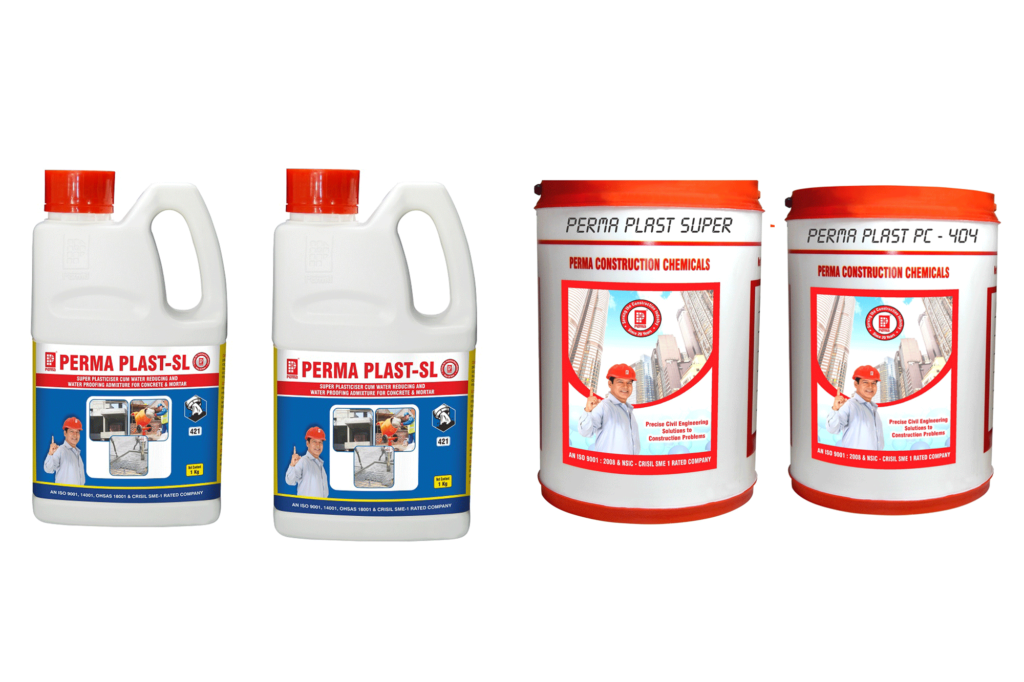Reinforced cement concrete has come to stay as an indispensable building material for the modern construction industry. Concrete used in various structures has different requirements with respect to functioning as an end product and also functional requirements vary with respect to its placement conditions, ambient temperature, distance it is required to travel before it is finally placed and compacted etc. There are different types of admixtures divided on their functionality and they are as follows:
- Waterproofing Admixtures
- Water-reducing Admixtures
- Air Entraining Admixtures
- Super Plasticizing Admixtures
- Set Retarding Admixtures
- Accelerating Admixtures
- Corrosion Inhibiting Admixtures
- Slump Retention Admixtures.
Waterproofing Admixtures
When cement concrete was adopted after the lime concrete and lime mortar era, the first problem faced by the construction engineers in comparison to the lime mortar/concrete was the shrinkage cracks and the leakages. Various laboratories studied this behaviour of cement concrete and put forward various solutions to get over this problem of shrinkage cracks and leakages. The suggestions of early stages are as follows:
Some advocated the use of lesser water or maintaining water cement ratio at 0.43. While some advocated the use of water repelling compounds in the concrete so that water falling on the concrete got repelled and did not enter the concrete so no leakages. And others advocated the use of air-entraining agents, to entrain three to four per cent air in the concrete so that the capillaries did not progress in the cement matrix. One per cent entrainment of air causes six per cent drop in compressive strength. This was an expensive proposition as it required extra cement for getting the same strength.
Water reducing Admixtures
As the requirement of higher strength in concrete increased one could go up to a limit, as cement content higher than 525 kgs per cubic meter of concrete produced shrinkage cracks. The need of good workability for better compaction and reduction of water cement ratio for better strength at work sites demanded water reducing admixtures. Based on the chemical composition the water reducing admixtures which are supplied in liquid form can be divided into four categories:
- Admixtures based on Ligno Sulphonates
- Admixtures based on Sulphonated naphthalene formaldehyde condensate
- Admistures based on Sulphonated melamine formaldehyde condensate
- Admixtures based on Poly Carboxylic ethers
Ligno sulphonates
The first admixtures which in concrete for water reduction were based on Lingo suphonates, which is simply referred to as lingo based admixtures. These admixtures are from natural sources and have some reducing sugars associated with them. They have a tendency to entrain 1-2 per cent air in the concrete and cause slight retardation in concrete.
Suphonated Naphthalene Formaldehyde Condensate
This range of admixtures, are synthetic inorganic ones in the form of dark brown liquids. They have slight accelerating property by nature and detrain air from the concrete. However retarding admixtures can also be made out by incorporating retarding elements. Their performance or water reducing property is proportional to their molecular weight. Their molecular weight ranges from 2000 to 30000 units.
Sulphonated Melamine Formaldehyde Condensate
This range of admixtures are more or less like naphthalene ones except that they are clear liquids. Such water reducing admixtures are quite useful in paver block and paver tile industry which uses white cement and pigments.
Air entraining Admixtures
More often higher compressive strength is not the criteria to ensure long performance life of a concrete structure. Concrete structure which are subjected to alternate drying and wetting spells, often disintegrate and crumble. This is experienced in most water retaining structures dams, canals and marine structures. To increase the resistance of concrete to these alternate drying and wetting conditions one needs to increase its soundness of concrete, which is achieved by entraining air. This is done by incorporating air entraining admixture in wet concrete which forms and evenly spreads micro fine air bubbles of the size of about 20 microns in the body of concrete.
Super Plasticizing Admixtures
For achieving high strengths in concrete one needs to reduce water cement ratios to a great extent. Normal water reducing admixtures reduce the water cement ratio to an extent of 25 per cent for getting the same workability.
Set Retarding Admixtures
When the concrete batching plant and the site of concrete pour are at a far off distance one needs concrete set retarding admixture. These admixtures could be based on lignos, naphthalenes, melamine or even PCs.
Accelerating Admixtures
In cold weather when the ambient temperatures fall below 10 degree C, concrete does not easily set. In such situations one uses an accelerating admixture. These admixtures are available in powder as well as in liquid forms.
Corrosion Inhibiting Admixtures
To prevent the corrosion of steel in the RCC structures and to lengthen the life of the structure itself, steel is coated with epoxy in a process known as fusion bonding. This is feasible on large projects. On small projects this practice is impractical. Certain chemicals are known to inhibit corrosion of steel.
Slump Retention Admixtures
Generally set retarding admixtures only help in maintaining the workability of concrete over long spells of time. Imbalance in the aggregate proportioning due to changing aggregates often creates problems on sites. Sands with too less fines create gap in the grading between the sizes of sands and cement. As a result of this the slurry often comes out and gets evaporated causing loss in workability. Fine aggregates with very high percentage of fines cause non setting of concrete in combination with retarding admixtures.
For more details, contact:
M A Waheed,Director – Technical,Perma Construction Aids Pvt Ltd
(A wholly owned subsidiary of Kansai Nerolac Paints Limited)
Cookie Consent
We use cookies to personalize your experience. By continuing to visit this website you agree to our Terms & Conditions, Privacy Policy and Cookie Policy.


















